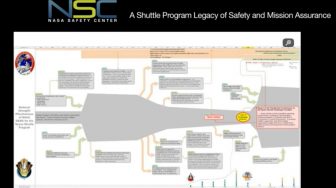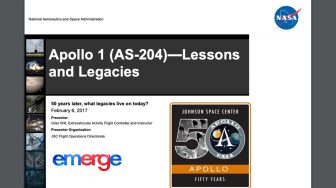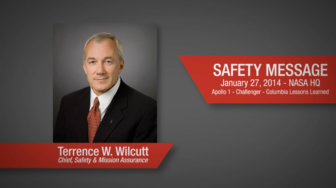results
-
 A Shuttle Program Legacy of Safety and Mission Assurance at JSC
A Shuttle Program Legacy of Safety and Mission Assurance at JSCThe NASA Safety and Mission Assurance (SMA) organizations have both taken pride in the successes, and shared responsibility for the catastrophic failures during 30 years of Space Shuttle Program operations. Lessons learned during this time period were presented showing the evolution of safety culture, processes and products. The intent of this presentation was to impart a legacy of safety protocol that can guide future enterprises to pursue a course of action that emphasizes dedication to minimizing the risk of catastrophic failures.
-
 Apollo 1 (AS-204) — Lessons and Legacies
Apollo 1 (AS-204) — Lessons and LegaciesJanuary 27, 2017 marked the 50th anniversary of the Apollo 1 fire. The NASA Safety Center hosted a session outlining the changes instituted as a result of the disaster and NASA’s safety cultural has greatly improved as a result of the lessons learned from the tragedy.
-
 Apollo 1 Case Study (SMA-OV-WBT-118)
Apollo 1 Case Study (SMA-OV-WBT-118)This course provides a brief overview of the Apollo 1 mishap which occurred at NASA KSC in 1967.
-

-
 Apollo 1-Challenger-Columbia
Apollo 1-Challenger-ColumbiaEvery year as we get back in the saddle, our Remembrance Day signals us to think back to the tragic events of Apollo 1, Challenger and Columbia as well as the context surrounding them. We’re accountable for learning from not just what went wrong, but how we recovered. As an example, read these rules recorded by Wayne Hale, former NASA Flight Director and Space Shuttle Program Manager. By actually applying such lessons from the past to your current work, our actions can honor our lost crews beyond silent reflection.
-
 Apollo 1-Challenger-Columbia Case Study
Apollo 1-Challenger-Columbia Case StudyWayne Hale’s Ten Rules for Engineering for Space is the focus of Remembrance Day 2014. As former NASA Flight Director and Space Shuttle Program Manager, Hale has compiled a list of lessons learned based on the Apollo 1, Challenger and Columbia disasters.
-
 Apollo 13 Case Study (SMA-OV-WBT-119)
Apollo 13 Case Study (SMA-OV-WBT-119)This course provides a brief overview of the Apollo 13 mishap which occurred in 1970.
-






